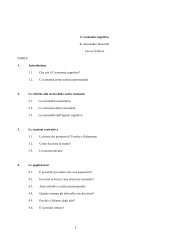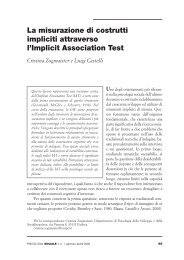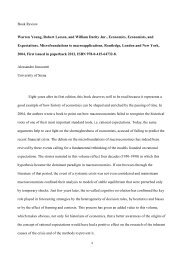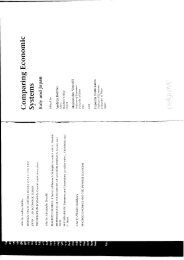The Advantages of Outsourcing in terms of Information ... - LabSi
The Advantages of Outsourcing in terms of Information ... - LabSi
The Advantages of Outsourcing in terms of Information ... - LabSi
You also want an ePaper? Increase the reach of your titles
YUMPU automatically turns print PDFs into web optimized ePapers that Google loves.
- no autonomy on product development, only execution <strong>of</strong> orders from the large firm.<br />
Hence the suppliers’ scope and <strong>in</strong>centives to <strong>in</strong>novate were limited.<br />
After the 1970s, new relationships have progressively been set up, follow<strong>in</strong>g both the<br />
vertical dis<strong>in</strong>tegration <strong>of</strong> large firms and the imitation <strong>of</strong> the Japanese model. Besides JIT, French<br />
firms imitated some aspects <strong>of</strong> the particular contractor-supplier relationships, such as the alreadymentioned<br />
pyramidal structure and the both the f<strong>in</strong>ancial participation <strong>in</strong> some subcontractors and<br />
the establishment <strong>of</strong> suppliers’ clubs, with the first-tier suppliers only. In Japan, such clubs are<br />
kyoryokukai, which concern the top <strong>of</strong> the pyramid structure <strong>of</strong> the network between the large firm<br />
and its strategic suppliers. Partnership relationships have several characteristics, close to the<br />
Japanese model:<br />
- trust, based <strong>in</strong> mutual commitment;<br />
- technological expertise <strong>of</strong> the supplier on its product (not just execution <strong>of</strong> orders);<br />
- short delivery times (JIT);<br />
- duration: procurement contracts are signed.<br />
In <strong>terms</strong> <strong>of</strong> <strong>in</strong>formation flows and knowledge exchange, two phases have to be<br />
dist<strong>in</strong>guished. In a first phase, broadly <strong>in</strong> the 1980s, French producers (and all Western producers <strong>in</strong><br />
general) outsource to reduce costs. Hence relationships rema<strong>in</strong> authoritative, the buyer mak<strong>in</strong>g<br />
precise requirements to the supplier and the supplier hav<strong>in</strong>g ma<strong>in</strong>ly execution tasks. More recently,<br />
<strong>in</strong> what can be called a second phase, broadly <strong>in</strong> the 1990s, co-operative relationships have been<br />
developed with some suppliers, <strong>in</strong>volv<strong>in</strong>g them earlier <strong>in</strong> the component design process (Dyer,<br />
1996). Important changes occur: the supplier is <strong>in</strong>volved <strong>in</strong> product development and has a capacity<br />
to <strong>in</strong>novate; pr<strong>of</strong>it ga<strong>in</strong>s and technological and economic <strong>in</strong>formation are shared. Hence <strong>in</strong>formation<br />
flows <strong>in</strong> the partnership relationships are two-way and differentiated, as <strong>in</strong> the Japanese model:<br />
generic <strong>in</strong>formation is shared and constitute the common denom<strong>in</strong>ator <strong>of</strong> the network, while each<br />
actor specialises <strong>in</strong> a certa<strong>in</strong> part <strong>of</strong> the overall <strong>in</strong>formation set related to the f<strong>in</strong>al product. Such<br />
features regard the first tier <strong>of</strong> suppliers because it is the only tier to be <strong>in</strong>volved <strong>in</strong> co-design.<br />
<strong>Information</strong> advantages are similar to those <strong>of</strong> the Japanese case.<br />
One <strong>in</strong>terest<strong>in</strong>g po<strong>in</strong>t to note is that such partnership relationships are supported by<br />
technological progress. <strong>The</strong> co-ord<strong>in</strong>ation across firm boundaries is <strong>in</strong>deed helped by the use <strong>of</strong><br />
<strong>in</strong>formation technology, and CAD (Computer Aided Design) systems <strong>in</strong> particular. Electronic data<br />
<strong>in</strong>terchange were first used for structured tasks, such as schedul<strong>in</strong>g, logistics and just-<strong>in</strong>-time. <strong>The</strong><br />
development <strong>of</strong> more <strong>in</strong>volvement <strong>of</strong> some suppliers <strong>in</strong> product development is associated with the<br />
use <strong>of</strong> IT for complex and creative tasks, such as jo<strong>in</strong>t design and eng<strong>in</strong>eer<strong>in</strong>g. In addition, IT helps<br />
<strong>in</strong>crease the efficiency <strong>of</strong> network relationships with suppliers s<strong>in</strong>ce electronic data <strong>in</strong>terchange and<br />
<strong>in</strong>dustry-wide platforms (e.g. the Automotive Industry Action Group) have been shown to help<br />
buyers reduce the costs <strong>of</strong> f<strong>in</strong>d<strong>in</strong>g an appropriate supplier, monitor subcontractors and co-ord<strong>in</strong>ate<br />
order<strong>in</strong>g, schedul<strong>in</strong>g and payment systems (Bensaou, 1999).<br />
Such co-design requires tight collaboration and <strong>in</strong>tense communication between the<br />
eng<strong>in</strong>eers <strong>of</strong> the buyer firm and the supplier. As stressed by Bensaou (1999, pp. 5), “the<br />
development <strong>of</strong> a new car or eng<strong>in</strong>e model is a large, complex project with several hundred<br />
eng<strong>in</strong>eers develop<strong>in</strong>g many new parts, tools and technologies. Design eng<strong>in</strong>eers translate the <strong>in</strong>itial<br />
broad design specifications <strong>in</strong>to detailed eng<strong>in</strong>eer<strong>in</strong>g draw<strong>in</strong>gs and/or design data files, which are<br />
either sent to subcontractors as the basis for production contracts or become the foundation <strong>of</strong><br />
eng<strong>in</strong>eers’ collaboration between buyers and suppliers”. Such <strong>in</strong>teractions occur <strong>in</strong> the context <strong>of</strong><br />
high uncerta<strong>in</strong>ty, time pressure and conflict <strong>of</strong> <strong>in</strong>terests between eng<strong>in</strong>eers so that <strong>in</strong>tense<br />
communication is required.<br />
In Italy, most large firms have outsourced by adjust<strong>in</strong>g to subcontractors' characteristics and<br />
chang<strong>in</strong>g radically their <strong>in</strong>ternal organization. For <strong>in</strong>stance, Camuffo and Volpato (2001) describe<br />
the case <strong>of</strong> the car <strong>in</strong>dustry, while Crestanello (1999) discusses the textile and cloth<strong>in</strong>g <strong>in</strong>dustry<br />
4
















